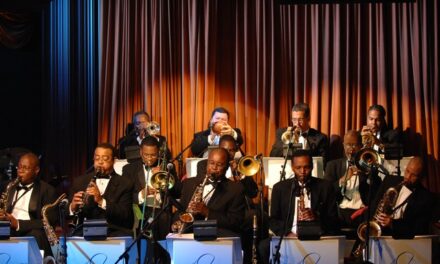Duke Performances is presenting the Spectrum Dance Theater/Donald Byrd in a two-night run at Reynolds Theater, offering a rare opportunity for dance lovers. The Seattle company will be performing The Theater of Needless Talents again on Feb. 20. Choreographed and directed by Byrd, Spectrum’s artistic director, the approximately 70-minute work combines dance with cabaret-like theatrics and spoken word. It is set to very interesting music, performed here on stage by members of the Mallarmé Chamber Players, by the little-known 20th century Czech composer Erwin Schulhoff.
Jointly commissioned from Spectrum by Duke Performances and the University of Notre Dame’s DeBartolo Performing Arts Center, The Theater of Needless Talents was inspired by the artists who, while in the Nazi death camps, continued to make art until they fell down dead. These artists included Schulhoff, who died in the Wülzburg camp in 1942, but the work draws particularly on the example of people in the Terezin (Theresienstadt) ghetto-camp in northwest Czechoslovakia. The work’s title refers to a Czech performance group from the 1930s, and is, of course, ironical — no talents are more needful to survival of the spirit than the capacity for laughter and the generation of beauty. Part of Duke Performances Art/Politics/Now series, the piece also attempts to link the Nazi genocide to more contemporary examples of mass killings. According to the program, it also “reminds audiences of the infallibility of the human spirit.” I suspect the writer meant “the indomitability of the human spirit,” since human spirit creates genocide along with art — and if the human spirit were infallible, then genocide wouldn’t be wrong.
The piece starts with a recitation of the gruesome statistics of death during World War II and ends with similar numbers from Cambodia, Burundi, Rwanda, Darfur, and other killing fields. During the body of the piece, dancers periodically speak some of the inspiring words that survived the Nazi attempts to obliterate their authors. But in The Theater of Needless Talents it is the beautiful dancing, expressing Byrd’s extraordinary choreographic language, that makes you know something about both their strength and the horror they endured. Byrd combines balletic and modern styles, along with steps and images from folk dances, to wonderful effect. You get the exquisite line of ballet, the rhythmic force of traditional dances, and the gravity and emotional weight of modern dance, all in one powerful package. The steps and sequences require an openness and strength in the lower torso and thighs that wordlessly conveys an unstoppable life force, even when the “story” is about death. Because of the piece’s structure, however, you don’t get a through-line. The “scene-changing” format, in which two or three dancers perform and the others make an audience, hampers the build-up of the emotional charge. Each section is amazing, but some energy is lost in the slightly draggy change-overs, and attention may wander for a moment. I’m not sure the work is as edifying as it desires to be, but it contains some of the most interesting movement I’ve ever seen.
The music, too, is endlessly intriguing. Played by Nancy Green, cello, Mayron Tsong, piano, Jacqueline Saed Wolborsky, violin, and Thomas Warburton, piano, the selections included Schulhoff’s beautifully textured Duo for violin and cello, which opened the dancing. Following were his piano solo works Suite Dansante, Five Jazz Etudes, and “Hot Music,” which preceded the heart-squeezing second movement of his Sonata for cello and piano at the end of the dance. Somehow, I found this music, once lost and forgotten, now dragged from the abyss of oblivion, a more compelling spur to action than all the grim numbers. Essentially, The Theater of Needless Talents asks the same question New York Times columnist Bob Herbert posed at Duke on the 18th in his talk on civic engagement. “What kind of world do you want to live in?” he asked—and then challenged us, as Byrd does, to make it so.
The Theater of Needless Talents repeats Feb. 20. See our calendar for details.











